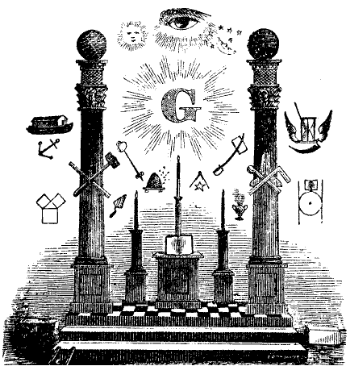The Chamber of Reflection
Jay Milla
by Brian Godwin, Culver City-Foshay No. 467
The Chamber of Reflection, dark, mysterious, and full of reminders of mortality, is one of the most overtly esoteric devices used in Freemasonry and, at times, has been controversial. It is intended to bestow upon a candidate somber feelings in respect to his own mortality, and emphasize the profundity of the next steps he will take. Some lodges give the option to all new candidates for Freemasonry to spend some thoughtful and reflective time in the chamber before initiation. The controversy around the use of the Chamber of Reflection, within the three degrees of craft Masonry stems from its seemingly spooky and morbid symbols of mortality. Additionally, some brethren feel that it is an “innovation” to adopt this tradition from other areas of Freemasonry, as it was not likely part of the original Preston-Webb system of degrees that is widely in use throughout the United States.
The Chamber is thought to have originated in the French and Scottish Rites of Freemasonry. It likely first appeared in France around 1750. Some suggest that the hermetic nature of its symbolism indicates a direct or indirect influence of Rosicrucianism. Others, including author and occultist Robert Ambelain, even suggest that Rosicrucians deliberately inserted their ideas and symbolism, including the use of the Chamber, into our Masonic traditions. Its form and contents have hardly changed since then, with only minor variations across jurisdictions, even with its recent adoption into the American blue (or craft) lodges. Most contain the following symbolism:
The Mirror: Literally a reflection of oneself, and traditionally a trigger for a meditative state. Representing duality, and the “twilight” of the moment that the candidate is in between his life before Freemasonry, and the transformation in which he is about to partake.
The Hourglass: A memento mori in many traditions, the hourglass overtly represents the finite amount of time that we are given in our earthly life. On a more esoteric level, it can represent the upper and lower, showing the cycle of life and death and the separation of Heaven and Earth. The possibility of turning the glass, symbolizes our need at times, to reverse our attitudes and actions for continuity, or we shall always be drawn to one end; the base.
The Scythe: It is another reminder of our earthly mortality and the thought that a man may be cut down from this existence at any moment. It may also be interpreted as an emblem of universal justice, that “as we sow, so shall we reap.”
Salt: Salt represents base matter, or body, rough and impure. It can be seen as representing the earthly self, ready to be purified. It is one of the three essential alchemical elements, also known as the “Tria Prima.”
Sulphur: Sulphur represents the soul, and essence above. It is also representative of fire, and is sometimes referred to as the “Red King” in practical alchemy. Sulphur is the second essential alchemical element.
The Cockerel: The Cockerel, or rooster, symbolizes the alchemical principle of mercury which creates a fluid connection between the salt below and the sulphur above. It represents the human spirit, which in this case can be differentiated from the “soul,” and represents a fluidity of spirit between the essence above and the firmament below. When partnered with salt and sulphur, the resulting mixture can be thought to symbolise faith, hope and charity.
Bread and Water: Two items connected with the simplest method of sustaining life. This simplicity is a reminder of how the candidate should proceed in all his dealings through life. They are also a reminder that “Man does not live by bread alone – but by the Word of the Living God”.
V.I.T.R.I.O.L.: Vitriol is another name for sulphuric acid, which at first glance seems to bring a negative connotation. This acid was used in alchemical experiments as a way to break down or purify other matter. In this case, V.I.T.R.I.O.L. is also an acronym, for “Visita interiora terrae, rectificando, invenies occultum lapidem”, or “Visit the interior of the earth, and purifying it, you will find the hidden stone.” This is another way of saying “Look within yourself for the truth.” Both meanings encourage the candidate to breakdown the ego and himself to find purity and truth within, and allude to the alchemical “Philosopher’s Stone”.
Human Skull and Crossed Thighbones: The history of the skull and crossbones is murky, and worthy of its own discussion. In the case of the Chamber, it is a bleak reminder of what we will all eventually become. It represents the alchemical concept of “Caput Mortuum,” signifying a useless substance left over from a chemical operation, such as sublimation and the epitome of decline and decay. Alchemists represented this residue with a stylized human skull, a literal death’s head.
Should a candidate choose to spend time in the Chamber prior to being entered into the fraternity, pen and paper are provided to write out any thoughts that might come to mind. This serves two purposes; first to help clear the mind of any burden of thought or concern, and also to provide a record of the moment, which is returned to the candidate when he reaches the sublime degree of Master Mason.
As the symbolism used within the Chamber is more deeply understood, it can bring light to the reasons why its recent adoption is becoming more prevalent in our first three degrees. This information can help us understand the concerns and controversy, while preserving its benefits. While these concerns do have some validity, the profound and positive effect on a candidate for Freemasonry transcends those criticisms and finds itself a valuable addition to our lodge and a truly memorable moment before our official ritual begins.
by Brian Godwin, Culver City-Foshay No. 467












